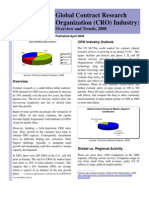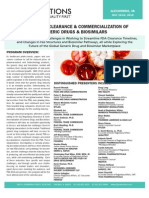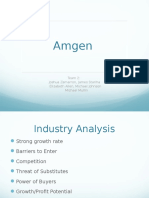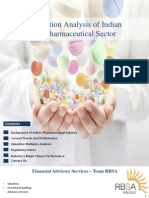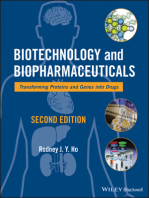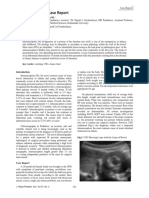The Active Pharmaceutical Ingredients (API) Market
The Active Pharmaceutical Ingredients (API) Market
Uploaded by
lek01Copyright:
Available Formats
The Active Pharmaceutical Ingredients (API) Market
The Active Pharmaceutical Ingredients (API) Market
Uploaded by
lek01Copyright
Available Formats
Share this document
Did you find this document useful?
Is this content inappropriate?
Copyright:
Available Formats
The Active Pharmaceutical Ingredients (API) Market
The Active Pharmaceutical Ingredients (API) Market
Uploaded by
lek01Copyright:
Available Formats
3
The Active Pharmaceutical Ingredients (API)
Market
Introduction
Scope and Segmentation
This study provides an overview of the global active pharmaceutical ingredients (APIs)
market. The API market can be broadly segmented into two segments depending on the
customer base:
■ Branded or innovator APIs
■ Generic APIs
For the purpose of this study, both branded as well as generic APIs have been included in the
assessment of all the qualitative and quantitative aspects.
Regulatory Processes: Issues and Concerns
The efficiency and expertise of Asian contract manufacturers have positioned them in a very
strategic space in the global pharmaceutical supply chain, with a vast majority of the APIs
and intermediates being sourced from markets such as India and China. However, over the
years, there have been several instances of non-compliance of APIs with the specified quality
standards, leading to an overall negative perception on other companies from the same
region.
#M3F6-52 © 2009 Frost & Sullivan www.frost.com September 2009 3-1
India and China produce a large percentage of a majority of the APIs and intermediates
produced in the world currently. While countries such as Japan and Singapore are signatories
to the ICH Q7 regulation, India and China follow their national GMP guidelines. This has
led to cases where there have been deviations with respect to critical aspects of the APIs such
as physico-chemical properties, stability or the impurity profile. A significant case in point is
Baxter's Heparin, which was withdrawn from the market after xx patients lost their lives and
several others fell ill after its consumption in early 2008. A delayed inspection by the FDA
indicated objectionable conditions in the Chinese manufacturing plant and contaminants
mixed in one particular batch. More recently, Ranbaxy was also banned from supplying a
particular drug in the US market, because of non-compliance.
While regulatory bodies such as the FDA and the EMEA have not directly established subsid-
iary offices in the Asian markets, they have published various guidelines for API
manufacturing 'Process Validation: General Principles and Practices', Annex 18—EU Good
Manufacturing Practices Active Pharmaceutical Ingredients (APIs), Pharmaceutical GMPs for
the 21st Century—A Risk-Based Approach Final Report, and Quality Systems Approaches to
Pharmaceutical Current Good Manufacturing Practice (GMP) Regulations. While companies
that export to regulated markets are expected to follow these guidelines, several of them do
not to cut costs and also because the degree of physical checks by the concerned regulatory
authorities is relatively lower.
Ta c k l i n g Q u a l i t y a n d S a f e t y I s s u e s
Although the overall cases of poor quality and unsafe APIs are relatively low, an increase in
the number of cases is likely to have a negative impact on the entire region. However, with
generics accounting for over xx.x per cent of the overall API production, contract manufac-
turers in Asia are estimated to account for over xx.x per cent of the overall small molecule
API production globally. In addition, India features the highest number of FDA-approved
units next only to the United States, and several hundreds of companies are involved in the
production and supply of APIs, formulations and finished dosage forms to the regulated
markets. The challenge for regulatory authorities from advanced markets is the continuous
physical inspection of hundreds of these units to ensure product quality and safety.
In 2007, warning letters were issued by the US FDA to two Chinese pharmaceutical manufac-
turers for GMP non-compliance, resulting in a denial of entry of the latter's products into the
United States. Following this, the US FDA has opened affiliate offices in Chinese cities such
as Beijing, Shanghai and Guangzhou to conduct periodical inspections to ensure that stand-
ards are met.
Suppliers of finished formulations, especially those based out of the United States and
Europe, express a certain degree of concern over APIs exported from emerging markets. The
only way of addressing this problem is the further harmonization between regulatory author-
ities and finished formulations suppliers with regard to the supervision and guidelines on
imported APIs. In addition, auditing guidelines should also be brought on par with global
standards with an increased frequency of inspections to ensure that there is greater consist-
ency in quality and product safety.
#M3F6-52 © 2009 Frost & Sullivan www.frost.com September 2009 3-2
Increasing Emphasis on Biopharmaceuticals: A Perspective
Biopharmaceuticals are pharmaceutical drugs based on protein, therapeutic serum, virus,
vaccine, blood component or derivative or gene transfer product. The active ingredients in
biopharmaceuticals are the proteins derived from living organisms or cells, whereas the
conventional small molecule drugs have chemical compounds as their active ingredients. As
they are complex macromolecules, biopharmaceuticals have a higher molecular weight and
lower manufacturing productivity than small molecules. In general, biopharmaceuticals are
directly administered into the blood stream by injection, as they are fragile molecules that
can degenerate easily in the human digestive system and are difficult to absorb into the
bloodstream by the walls of the intestinal tract.
Manufacturing of biopharmaceuticals is a capital-intensive, complex and highly technical
process in comparison to that of small molecules. The outsourcing of biopharmaceuticals
manufacturing is becoming increasingly attractive, driven by the lack of captive manufac-
turing capacity with mid and small biotechnology companies that drive the research and
development pipeline. The business model of contract manufacturing organisations (CMOs)
is rapidly evolving to suit the changing demands of biopharmaceutical innovation, with over
xx.x per cent of biopharmaceutical companies outsourcing some form of their biopharmaceu-
tical production. CMOs have also adapted well to the change by offering value-added
services such as packaging, logistics and anti-counterfeiting in addition to traditional manu-
facturing, making outsourcing increasingly attractive option.
The global biopharmaceuticals market is poised to grow from $xx.xx billion in 2007 at a
compound annual growth rate (CAGR) of xx.x per cent between 2007 and 2014. The
demand for biopharmaceuticals is expected to increase in the emerging markets, where the
penetration currently is minimal at present. Korea, India and China are witnessing an
upsurge of biopharmaceutical manufacturing capacity, a majority of which are likely to come
online by 2010. This capacity should enable the lowering of cost of biopharmaceuticals,
thereby making them more affordable. The commoditization of biogenerics in the future is a
key challenge for biopharmaceutical companies, which have been able to sustain and expand
their business through the high pricing of biopharmaceutical products. Countries such as
India and China have been competing based on pricing, and their impact on the small mole-
cule generics business has been significant.
Within biopharmaceuticals, monoclonal antibodies and therapeutic proteins are the rapidly
growing segments, with forecast compound annual growth rates of xx.x per cent and
xx.x per cent, through 2011.
The leading recombinant protein-based drug classes in 2007 were:
■ Erythropoietin (€x billion)
■ Recombinant human insulin (€x.x billion)
■ Granulocyte colony-stimulating factors (€x.x billion)
#M3F6-52 © 2009 Frost & Sullivan www.frost.com September 2009 3-3
Market Overview
APIs that form the basis for every formulated end product are primarily an off-shoot of the
specialty/fine chemicals industry. Depending on the customer base, APIs can be broadly clas-
sified into two key segments:
■ Innovator or branded drugs
■ Generics
Innovator APIs which were traditionally the largest segment are continuing to grow much
more slowly in comparison with generic APIs, which constitute the fastest growing segment.
With several key brands going off-patent, and as and consolidation in the pharmaceutical
industry, the demand for branded APIs has gone down significantly over the years. Conse-
quently, generic APIs have witnessed a boom, and are expected to continue growing steadily,
with further expected patent expiries and a subsequent increase in generic production capac-
ities globally.
Furthermore, concerns of rising healthcare expenses have reduced the prescription volumes
of innovator drugs significantly. According to figures from IMS health, in 2008, prescription
drug spending at wholesale prices increased by x.x per cent, which was a huge decline
compared to the growth rate of x.x per cent in 2007. Over the period from 2002 to 2008, the
year-on-year prescription growth rate has been found to decrease by xx per cent. This was
due to the lower impact of certain new products that were launched in the past five to seven
years. The ongoing economic recession has also exacerbated this problem by prompting a
shift towards generics. Several patients who have lost their means to pay their health insur-
ance premiums have increased their generics consumption. Moreover, certain insurance plans
have lowered the co-payment on generics and increased the same on innovator drugs.
Internally, the pharmaceutical companies are restructuring their operations significantly
taking a very opportunistic stand on what drugs to manufacture in-house and what to
outsource. For instance, market participants such as Pfizer, GlaxoSmithKline, Sanofi-Aventis,
Bayer healthcare and Abbott have downsized manufacturing over the past two years, and are
in the process of identifying high-margin drugs and producing only those in-house.
In the pharmaceutical industry, API sourcing is increasingly being considered as a highly crit-
ical strategic decision. While most of the demand in value terms for APIs is still from the
United States and Europe, the role of the Asia Pacific region as a key location for API
sourcing is becoming more prominent. Due to the current restructuring of the pharmaceutical
industry, API CMOs are expected to witness a strong upsurge in demand, particularly in the
generics sector. However, in the innovator drugs segment, a major portion of the manufac-
turing process is still controlled by big pharma and the role of CMOs is limited.
#M3F6-52 © 2009 Frost & Sullivan www.frost.com September 2009 3-4
Market Engineering Research
Market Engineering Measurements
Chart 3.1 illustrates the Market Engineering measurements for the Global active pharmaceu-
tical ingredients market in 2008.
Chart 3.1
Active Pharmaceutical Ingredients Market: Market Engineering Measurements (World), 2008
Challenge
Identification
Market
Engineering Market
System Research
Market Engineering Drives Market
Market
Engineer
Strategy and Planning Market
Implementation Strategy
Market
Planning
Measurement Name Measurement Trend
Market age Development stage ---
Price sensitivity xxxx
Number of products Greater than x,xxx Increasing
Degree of technical change xxxx
Competitors (active market competitors in base year) Greater than x,xxx Increasing
Market concentration (per cent of base year market controlled by Lesser than xx.x%
top three competitors)
Note: All figures are rounded; the base year is 2008. Source: Frost & Sullivan
Industry Challenges
Figure 3-1 illustrates the impact of top four industry challenges for the Global active phar-
maceutical ingredients market from 2009 to 2015.
#M3F6-52 © 2009 Frost & Sullivan www.frost.com September 2009 3-5
You might also like
- GMP in Pharmaceutical Industry: Global cGMP & Regulatory ExpectationsFrom EverandGMP in Pharmaceutical Industry: Global cGMP & Regulatory Expectations5/5 (2)
- Manufacturing Landscape: Clarivate Analytics NewportNo ratings yetManufacturing Landscape: Clarivate Analytics Newport6 pages
- Brand Management-Pharmaceutical IndustryNo ratings yetBrand Management-Pharmaceutical Industry83 pages
- Biopharmaceuticals Are Among The Most Sophisticated and ElegantNo ratings yetBiopharmaceuticals Are Among The Most Sophisticated and Elegant8 pages
- Rapid Growth in Biopharma - Challenges and Opportunities - McKinsey & CompanyNo ratings yetRapid Growth in Biopharma - Challenges and Opportunities - McKinsey & Company9 pages
- Pharma Industry: Vipul Murarka Vibhuti SharmaNo ratings yetPharma Industry: Vipul Murarka Vibhuti Sharma37 pages
- Biopharmaceuticals - A Global Market OverviewNo ratings yetBiopharmaceuticals - A Global Market Overview24 pages
- Global Biosimilars Market Regulations & Pipeline InsightNo ratings yetGlobal Biosimilars Market Regulations & Pipeline Insight5 pages
- The Indian Pharmaceutical Industry Is Highly FragmentedNo ratings yetThe Indian Pharmaceutical Industry Is Highly Fragmented3 pages
- Fraud or Negligence in Drug Quality Standards Not A Fraud On Patients?No ratings yetFraud or Negligence in Drug Quality Standards Not A Fraud On Patients?7 pages
- Exploratory Study On Active Pharmaceutical Ingredient Manufacturing For Essential MedicinesNo ratings yetExploratory Study On Active Pharmaceutical Ingredient Manufacturing For Essential Medicines52 pages
- Accenture A Strategy For Focused GrowthNo ratings yetAccenture A Strategy For Focused Growth16 pages
- Abbott Laboratories: Shih-Yi Chang, Richie Hartz, Anastasia Sutjahjo Nov.27,2012No ratings yetAbbott Laboratories: Shih-Yi Chang, Richie Hartz, Anastasia Sutjahjo Nov.27,201231 pages
- Q1 Productions Regulatory Clearance & Commercialization of Generic Drugs & BiosimilarsNo ratings yetQ1 Productions Regulatory Clearance & Commercialization of Generic Drugs & Biosimilars4 pages
- Pfizer and The Challenges of The Pharmaceutical IndustryNo ratings yetPfizer and The Challenges of The Pharmaceutical Industry36 pages
- Strategic Management Assignment (Est) : Regulatory FrameworksNo ratings yetStrategic Management Assignment (Est) : Regulatory Frameworks4 pages
- IQ4I Research & Consultancy Published A New Report On "Biologics Outsourcing Global Market - Forecast To 2028No ratings yetIQ4I Research & Consultancy Published A New Report On "Biologics Outsourcing Global Market - Forecast To 20289 pages
- The New Trend of API Sourcing and Contract Manufacturing in ChinaNo ratings yetThe New Trend of API Sourcing and Contract Manufacturing in China15 pages
- The Pharma Regulatory Code: Global Standards and Compliance StrategiesFrom EverandThe Pharma Regulatory Code: Global Standards and Compliance StrategiesNo ratings yet
- Factors Affecting the Sales of Independent Drugstores (A Historical Perspective)From EverandFactors Affecting the Sales of Independent Drugstores (A Historical Perspective)No ratings yet
- Biotechnology and Biopharmaceuticals: Transforming Proteins and Genes into DrugsFrom EverandBiotechnology and Biopharmaceuticals: Transforming Proteins and Genes into DrugsNo ratings yet
- Current Good Manufacturing Practices (cGMP) for Pharmaceutical ProductsFrom EverandCurrent Good Manufacturing Practices (cGMP) for Pharmaceutical ProductsNo ratings yet
- Prefix, Root, Suffix Examples (Generic Names) Drug Class or Drug CategoryNo ratings yetPrefix, Root, Suffix Examples (Generic Names) Drug Class or Drug Category5 pages
- 5 Jurnal Darini Revisi Turnitin TemplateNo ratings yet5 Jurnal Darini Revisi Turnitin Template8 pages
- Clinician Scientist Canada White Paper eNo ratings yetClinician Scientist Canada White Paper e26 pages
- Ehealth Strategy For NSW Health 2016 2026 PDFNo ratings yetEhealth Strategy For NSW Health 2016 2026 PDF40 pages
- St. Anthony College of Roxas City, CapizNo ratings yetSt. Anthony College of Roxas City, Capiz13 pages
- Group 4 (Telling Time, Date, and Doctor Schedule)No ratings yetGroup 4 (Telling Time, Date, and Doctor Schedule)4 pages
- 1.2 Purpose of Cystoclysis: 1. Closed Bladder Irrigation SystemNo ratings yet1.2 Purpose of Cystoclysis: 1. Closed Bladder Irrigation System6 pages
- Perencanaan Kebutuhan Obat Bulanan Klinik Pratama Rossa MedikaNo ratings yetPerencanaan Kebutuhan Obat Bulanan Klinik Pratama Rossa Medika2 pages
- National Quality Assurance Standards: Mandatory Requirements PHC/CHCNo ratings yetNational Quality Assurance Standards: Mandatory Requirements PHC/CHC14 pages
- Discoloration of Teeth: A Literature ReviewNo ratings yetDiscoloration of Teeth: A Literature Review5 pages
- GMP in Pharmaceutical Industry: Global cGMP & Regulatory ExpectationsFrom EverandGMP in Pharmaceutical Industry: Global cGMP & Regulatory Expectations
- Manufacturing Landscape: Clarivate Analytics NewportManufacturing Landscape: Clarivate Analytics Newport
- Biopharmaceuticals Are Among The Most Sophisticated and ElegantBiopharmaceuticals Are Among The Most Sophisticated and Elegant
- Rapid Growth in Biopharma - Challenges and Opportunities - McKinsey & CompanyRapid Growth in Biopharma - Challenges and Opportunities - McKinsey & Company
- Global Biosimilars Market Regulations & Pipeline InsightGlobal Biosimilars Market Regulations & Pipeline Insight
- The Indian Pharmaceutical Industry Is Highly FragmentedThe Indian Pharmaceutical Industry Is Highly Fragmented
- Fraud or Negligence in Drug Quality Standards Not A Fraud On Patients?Fraud or Negligence in Drug Quality Standards Not A Fraud On Patients?
- Exploratory Study On Active Pharmaceutical Ingredient Manufacturing For Essential MedicinesExploratory Study On Active Pharmaceutical Ingredient Manufacturing For Essential Medicines
- Abbott Laboratories: Shih-Yi Chang, Richie Hartz, Anastasia Sutjahjo Nov.27,2012Abbott Laboratories: Shih-Yi Chang, Richie Hartz, Anastasia Sutjahjo Nov.27,2012
- Q1 Productions Regulatory Clearance & Commercialization of Generic Drugs & BiosimilarsQ1 Productions Regulatory Clearance & Commercialization of Generic Drugs & Biosimilars
- Pfizer and The Challenges of The Pharmaceutical IndustryPfizer and The Challenges of The Pharmaceutical Industry
- Strategic Management Assignment (Est) : Regulatory FrameworksStrategic Management Assignment (Est) : Regulatory Frameworks
- IQ4I Research & Consultancy Published A New Report On "Biologics Outsourcing Global Market - Forecast To 2028IQ4I Research & Consultancy Published A New Report On "Biologics Outsourcing Global Market - Forecast To 2028
- The New Trend of API Sourcing and Contract Manufacturing in ChinaThe New Trend of API Sourcing and Contract Manufacturing in China
- The Pharma Regulatory Code: Global Standards and Compliance StrategiesFrom EverandThe Pharma Regulatory Code: Global Standards and Compliance Strategies
- Factors Affecting the Sales of Independent Drugstores (A Historical Perspective)From EverandFactors Affecting the Sales of Independent Drugstores (A Historical Perspective)
- Biotechnology and Biopharmaceuticals: Transforming Proteins and Genes into DrugsFrom EverandBiotechnology and Biopharmaceuticals: Transforming Proteins and Genes into Drugs
- Pharmacovigilance Medical Writing: A Good Practice GuideFrom EverandPharmacovigilance Medical Writing: A Good Practice Guide
- Current Good Manufacturing Practices (cGMP) for Pharmaceutical ProductsFrom EverandCurrent Good Manufacturing Practices (cGMP) for Pharmaceutical Products
- Prefix, Root, Suffix Examples (Generic Names) Drug Class or Drug CategoryPrefix, Root, Suffix Examples (Generic Names) Drug Class or Drug Category
- 1.2 Purpose of Cystoclysis: 1. Closed Bladder Irrigation System1.2 Purpose of Cystoclysis: 1. Closed Bladder Irrigation System
- Perencanaan Kebutuhan Obat Bulanan Klinik Pratama Rossa MedikaPerencanaan Kebutuhan Obat Bulanan Klinik Pratama Rossa Medika
- National Quality Assurance Standards: Mandatory Requirements PHC/CHCNational Quality Assurance Standards: Mandatory Requirements PHC/CHC















